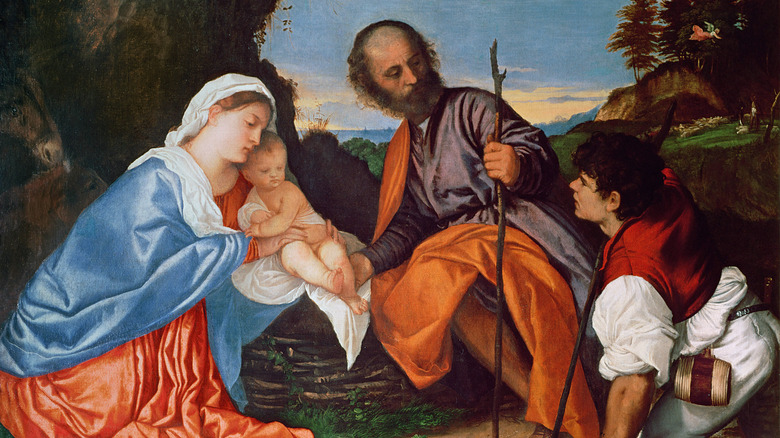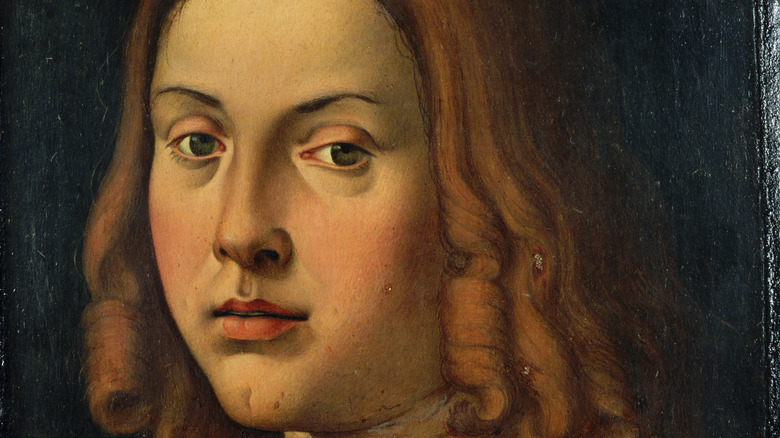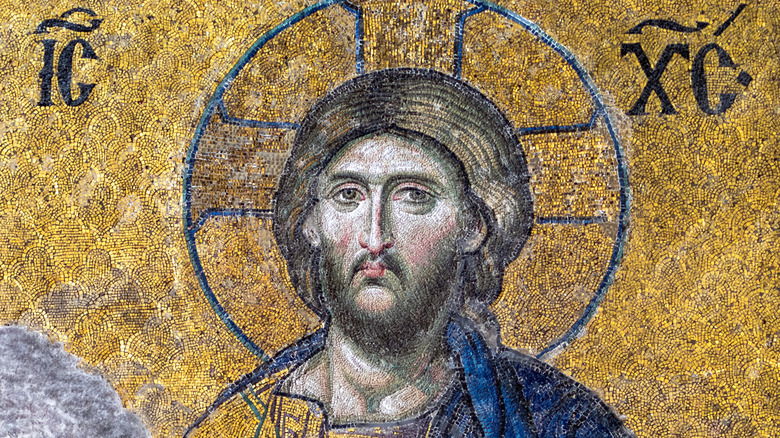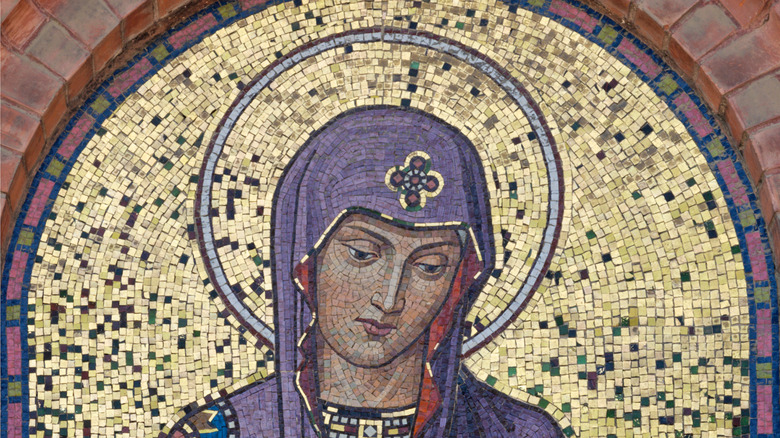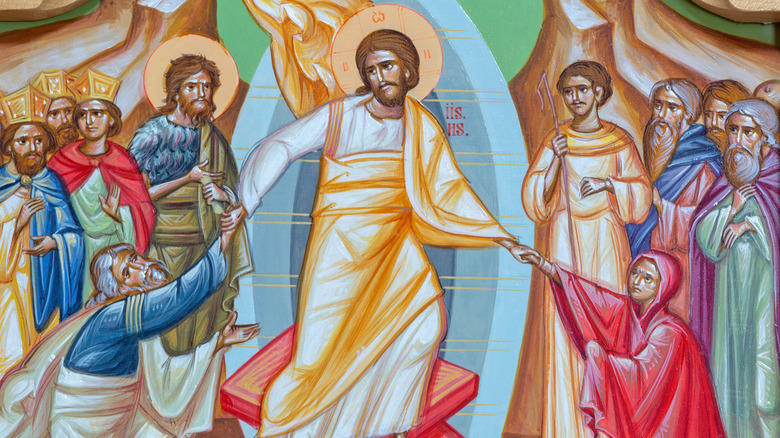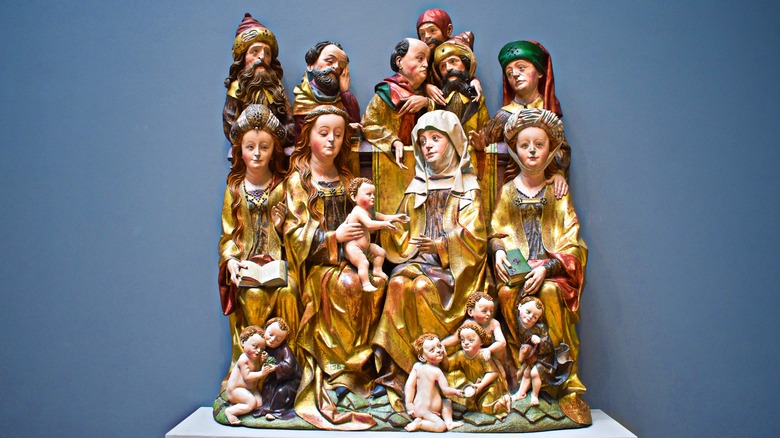Mysteries About Jesus That Are Still Unsolved
If there was a contest for the most famous person in human history, surely one of the top contenders would be Jesus Christ. He's the figure at the center of Christianity, currently the globe's top religion, with more than 2 billion estimated adherents worldwide. Enter any church, and you're likely to encounter some image of him, or at least hear his story related via the Gospels that make up the first four books of the Bible's canonical New Testament. Even if you're not among the faithful, it's pretty hard to have not heard of his life story and the religion that bloomed from his teachings.
But, despite his long-lasting renown, the reality is that there is quite a lot that we don't know about Jesus. After all, he lived and died some 2,000 years ago, long before things like photography or voice recording were a thing. We have no direct interviews with him or physical remains to test. Beyond what's in the Bible or the religious traditions that have grown from those books, we have no account of what he did or said. Even a clear-eyed reading of the Gospels won't illuminate some key facts about the man, including what he looked like, the nature of his family relationships, and even sometimes the particulars of the miracles he is said to have worked. As a result, we're left with some lingering mysteries about Jesus that remain unsolved to this day.
We can't be sure when he was born
If you happen to live in a place where Christmas is a widespread celebration, the occasion of Jesus' birth feels like it's set in stone. Why would we make such a big deal out of December 25 if the date wasn't confirmed? Except that's exactly the case. For one, the earliest Christians didn't bother celebrating Jesus' birth. It wasn't until A.D. 336, 300 years after Jesus' death, that the church finally got around to officially honoring the occasion. By then, if anyone once knew the exact date, it was apparently lost to time.
As for the selection of December 25, it could be that the date was picked to compete with pagan holidays, or that ancient historians simply miscalculated. We're not even sure what year Jesus was born in. At least the Gospel account of King Herod hunting for the infant Jesus suggests Jesus was born at some point before Herod's death in about 4 B.C. — though, given the shaky details, some scholars wonder if Herod may have died earlier.
Either way, many now argue that Jesus was born in summer or fall, as the angels reportedly appeared to shepherds in the fields — and those shepherds would have been huddled inside with their flocks if it really was the cold, waning days of December. Still, without much else to go on in the Gospels or beyond, the actual birth date of Jesus will likely remain a mystery.
His birthplace isn't obvious
If we're not clear on when Jesus was born, then surely his birthplace is easier to pin down. It's not just that some of us have sung "O Little Town of Bethlehem" at the holidays, name-dropping the spot of the very first nativity scene. Even though that song is based on a 19th-century American poem, the Bible itself says Bethlehem is the place in Matthew 2:1 and Luke 2:1-7.
Too bad the rest of the Bible doesn't necessarily agree. While Matthew and Luke point to Bethlehem as Jesus' birthplace, the Gospel of Mark doesn't mention it at all. Neither does the Gospel of John have anything to say on the location. That's not definitive evidence that Jesus wasn't born in Bethlehem, but it seems like an odd detail to omit, especially given that Mark was written in A.D. 60, just an estimated 30 years after Jesus died. There, much is made of Jesus being a descendant of King David, who was associated with Bethlehem, but Mark also links him to Nazareth and John to the region of Galilee.
What's more, earlier Jewish texts wrote that a messiah would come out of Bethlehem. It could be that later writers linked Jesus and Bethlehem to strengthen the case that he really was the messiah, where earlier writers apparently felt no need to do so. Either way, it's sure to be a question that sets off serious debate at just about any theological conference.
What was teenage Jesus doing?
The Gospels spend quite a lot of time on the story of Jesus' birth, followed by a bit of information on his early years. But after Luke 2:41-52 tells the story of a 12-year-old Jesus speaking with learned people in the temple, the trail goes cold. We don't pick the narrative up again until Jesus is an adult poised at the very beginning of his ministry, when he would have been about 30 years old. That leaves us with a tremendous 18-year gap in the tale. So, what the heck did a teenaged and 20-something Jesus get up to in that time?
The answer depends on who you want to listen to. If we're going only by the canonical books of the Bible accepted by most Christian churches, we're left in the lurch. If you're willing to turn to apocryphal texts that aren't part of the official narrative, you get a little more detail, especially with the Gospel of Thomas that purports to tell incidents from his life from 5 to 12 or so. Go even farther afield, at least textually speaking, and you'll encounter legends with all sorts of proposals for what Jesus was doing in those lost years. The most likely: He was trucking along as a carpenter (technically, a sort of handyman known as a tektōn) for most of that time. But more colorful accounts claim that he traveled as far as India, Japan, or even Britain to gain mystical knowledge.
The date of his death is debatable
Though most historians and theologians agree that Jesus died in his early 30s, getting more detailed than that is surprisingly tricky. Inconsistencies in the Gospel accounts, as well as a generally different sense of timekeeping between the ancient world and today, are two of the biggest sticking points. One key factor: The Gregorian calendar that many of us use today only came into official use when Pope Gregory XIII gave it the go-ahead in 1582. What's more, the way Jewish people would have calculated days was from one sundown to another, much like how observant Jews honor the Sabbath today. Looking at the Gospels, we can reasonably guess that Jesus died sometime around Passover, given how the writers repeatedly mention the occasion — Mark 14:12-14 even directly says that the Last Supper was a Passover meal. He may have been crucified during an eclipse, though that evidence remains speculative.
In the journal New Testament Studies, religious scholar Helen Bond argues that it's still practically impossible to get a particular date down for these reasons, even though other scholars have held on to the notion that April 7, A.D. 30, was the exact date of the Crucifixion ... because they really wanted it to be true. But Bond instead argues that the evidence indicates he died around Passover somewhere between A.D. 29 to 34. Beyond that, anyone who tries to nail the details down further is more likely to be grasping at straws.
We don't know what Jesus looked like
If you've attended a Christian church, then it's all but certain that you've come across multiple images of Jesus on display. But how accurate are those portraits? One of the biggest mysteries of Jesus is that we don't really know what he would have looked like, meaning all of those beloved images of the man are based on speculation.
Not that speculation is necessarily a terrible idea. We can make a pretty informed guess about Jesus' physical looks based on the common appearance of Judean men at the time, given that no one mentions Jesus looking out of the ordinary. Researchers using male skeletal remains from first-century Galilee as their basis have created a model of Jesus that has medium-brown skin, relatively short, curly hair, and a muscular build that would have been appropriate for a handyman laborer. Still, these depictions can only guess at it all, as we have no detailed first-hand descriptions or physical remains to point us to the real Jesus.
Yet, it's clear that the intervening centuries have given us a depiction of Jesus that's heavily influenced by our own cultures and individual perceptions. The image of a long-haired, bearded Jesus, for instance, is more of a Byzantine invention meant to make him look philosophical and authoritative according to the ideals of the time (and maybe the image of pagan deity Zeus). By contrast, the earliest known Christian artwork of Jesus shows him clean-shaven and with short hair.
We aren't sure he was single
The standard line in many churches is that Jesus was very definitely single, and nothing in the Bible definitively says that Jesus was married. (Early Christian leader Paul does refer to the church as Christ's metaphorical wife.) But neither does it clearly state that he was never married. It sparked major debate in the early church, as some of the first official Christians argued over whether it was better to remain celibate or get married. Some used Jesus' seeming singleness as support for celibacy, while others wrote as early as the second century that Jesus may have been a married man.
Apocryphal books not part of the official canon make things even more confusing. The Gospel of Jesus's Wife, a seventh to eighth-century fragment of papyrus written in Egyptian Coptic (but maybe based on an earlier Greek text), contains a line from Jesus in which he refers to a wife. Some academics have taken it as a clear reference to a real, human wife. Others say it's just the church metaphor all over again.
Perhaps, as Oxford historian Diarmaid MacCulloch pointed out to The Guardian, "it was almost certainly written in the context of an early debate on the position of women in the church." The fragmentary gospel does seem pretty focused on the possible wife, another disciple, and Jesus' mother, Mary, perhaps speaking more to the wider debate over women's role in the church than whether or not there was a Mrs. Jesus.
How could he have walked on water?
One of the early miracles of Jesus' ministry is the spectacular phenomenon of him walking on the waters of the Sea of Galilee. In Matthew 14:22-33, the disciples of Jesus are out fishing while Jesus is praying. He decides to go see them and, as one does, begins to walk out to their boat on the surface of the water. The astonished men proclaim him to be the true Son of God.
But how did Jesus do it? For many, the straightforward answer is that it's a miracle. For others, a bit more explanation is needed — and therein lies the mystery. One theory, proposed by oceanographer Doron Nof in a 2006 issue of the Journal of Paleolimnology, is that the Sea of Galilee (actually a freshwater lake) could have partially frozen over, as the climate then was much cooler. It wouldn't have been enough to stop a fishing boat from going out, but could have provided a thin, precarious surface for Jesus to walk upon.
Or, maybe our reading comprehension isn't up to snuff. Some scholars have suggested that the "upon the sea" line of the original Greek text should be translated to mean that Jesus was walking on the shore or maybe through the shallows. Perhaps, confused by low light and adverse weather, the disciples thought he was strolling on the water. Unless we can travel back to the time and place of the incident, many of us are left wondering.
It's not obvious what Jesus was doing between death and resurrection
According to the narrative of the Crucifixion, Jesus died on Friday and was resurrected on Sunday. Then what was happening that Saturday? With all of the miraculous and mystical elements of the story, many can't help but wonder if something else was going on during that time that the Bible fails to clarify.
That's not to say the Bible is entirely mum on the matter. Luke 23:42-43 has Jesus promising one of his fellow crucifixion victims that they'll be together in paradise that day, implying Jesus hung out in heaven before returning to Earth. 1 Peter 3:18-20 implies that a post-Crucifixion Jesus "went and preached unto the spirits in prison," while 1 Peter 4:6 says that the gospel was preached to the dead. The Apostles' Creed, a statement of faith that may have appeared as early as the second century but wasn't finalized until the sixth or seventh century in France, claims directly that Jesus "descended into hell" after his burial.
These have led to the concept of the harrowing of hell, in which Jesus was believed to have taken that day to descend into the underworld to preach to the souls of good people who hadn't heard of Jesus. It was also an opportunity for medieval artists to show Jesus beating up demons and triumphing over evil. However cool artists may have found the concept over the centuries, though, it's still not directly attested in the canonical Bible.
Did Jesus think he was the messiah?
For modern Christians, the notion that Jesus was the longed-for messiah is so widely understood and accepted that to question it is nigh-on heresy. That was also the case for the followers of Jesus, who seem to have quickly proclaimed him to be the redeemer and rescuer that had been predicted by earlier Jewish thinkers. The mystery here lies with Jesus himself: Did he think that he was the messiah?
Religious scholar Bart Ehrman argues that it's likely Jesus really did think he was all that, noting that the Gospel of John has Jesus calling himself the Son of God and directly referring to himself as the messiah, and making comments that imply he's existed for a long time and is only on a brief, earthly sojourn from heaven. However, Ehrman admits that this could all be an invention of the gospel writer, and it's not clear if the real Jesus said these things. (John was written sometime between A.D. 90 and 100, a full generation after Jesus died.)
What's more, while speaking to NPR, Ehrman pointed out that it's really only John where these statements crop up. The other Gospels, all of which were written earlier, don't have anything direct to say about it. And if Jesus was making such an immense claim as to propose that he was the messiah, why would Matthew, Mark, and Luke have never mentioned it?
Who were Jesus' siblings?
Few churches have lovingly displayed images of Christ's siblings alongside Mary, Joseph, and Jesus himself. But maybe there's good reason for that omission. Even though they are briefly mentioned in the Bible, the sisters and brothers of Jesus have remained mysterious figures for centuries.
Multiple verses in the Gospels vaguely mention brothers of Jesus, while Matthew 13:55 calls out at least a few of them by name, mentioning James, Joseph (or Joses), Simon, and Judas (no relation to the infamous disciple Judas Iscariot). The next verse also says that Jesus had sisters, though none are named. Some siblings appear to have been skeptical of his ministry, but others became all-in, like when James became an early church leader (and who may have also been executed, if we are to believe first-century historian Josephus).
But what to make of these siblings? And what implications do they have for Jesus' mother, Mary? For some branches of Christianity, it's important that Mary remain a virgin throughout her entire life, a doctrine known as her perpetual virginity. The Catholic Church's stance, therefore, is that these siblings were actually cousins. Or perhaps these were half-siblings through Joseph only, who may have been significantly older than Mary and brought children from a previous marriage to their relationship. However, the Bible doesn't say anything to support either of these theories. This leads others to argue that, no, these were really siblings of Jesus, but ultimately the matter remains up in the air for many readers.

